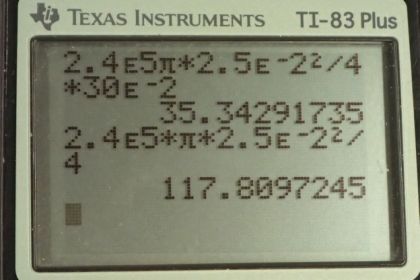Question
A hand-driven tire pump has a piston with a 2.50-cm diameter and a maximum stroke of 30.0 cm. (a) How much work do you do in one stroke if the average gauge pressure is (about 35 psi)? (b) What average force do you exert on the piston, neglecting friction and gravitational
force?
Final Answer
Solution video
OpenStax College Physics for AP® Courses, Chapter 15, Problem 13 (Problems & Exercises)

vote with a rating of
votes with an average rating of
.
Calculator Screenshots
Video Transcript
This is College Physics Answers with Shaun Dychko. The work that we do on the hand pump is going to be the pressure we add, which is the gauge pressure multiplied by its change in volume. We’re told that it's a cylinder and we are given the diameter of the cylinder and the distance through which it is pushed its stroke length in other words, and so the change in volume then is going to be the volume of this cylinder that you can imagine the piston traveling through so it’s gonna go through some height h and the piston has some diameter D and so the change in volume is Pie r squared times h and radius can be substituted with half diameter so diameter over 2. This works out to Pie times diameter squared times h over 4. So we'll plug that in for Delta V and then substitute the numbers as well and we have a gauge pressure of 2.4 times 10 to the 5 newtons per square meter times Pie times the diameter of two and a half centimeters, which converted into meters and square that divided by 4. Then multiplied by 30 centimeters also converted into meters by multiplying by 10 to the minus 2 and we get 35.3 Joules is the work done by the person. Now the force applied is going to be the gauge pressure times the area of the piston and so that’s gonna be 2.4 times 10 to the 5 newtons per square meter times Pie times the diameter of two and a half centimeters squared divided by 4, which is 118 newtons.
